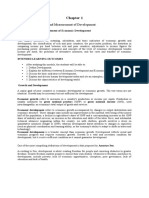1.1 When Is The Economy Performing Well?: Macroeconomics - Chapter 1
1.1 When Is The Economy Performing Well?: Macroeconomics - Chapter 1
Uploaded by
Kevin D'LimaCopyright:
Available Formats
1.1 When Is The Economy Performing Well?: Macroeconomics - Chapter 1
1.1 When Is The Economy Performing Well?: Macroeconomics - Chapter 1
Uploaded by
Kevin D'LimaOriginal Title
Copyright
Available Formats
Share this document
Did you find this document useful?
Is this content inappropriate?
Copyright:
Available Formats
1.1 When Is The Economy Performing Well?: Macroeconomics - Chapter 1
1.1 When Is The Economy Performing Well?: Macroeconomics - Chapter 1
Uploaded by
Kevin D'LimaCopyright:
Available Formats
MACROECONOMICS CHAPTER 1 1.1 WHEN IS THE ECONOMY PERFORMING WELL?
? At the broad level, we would say that a macroeconomy is performing well if it meets the following criteria: Rising Living Standards in the Long Run
Providing a framework within which contrives can grow and increase standards of living for the people is an important responsibility of governments and international organisations such as the World Bank. Macroeconomists study these long-run growth issues, using what is known as growth theory. GROWTH THEORY The study of the long-run growth performance of economies Avoiding extremes of short-run macroeconomic performance
Where countries experience the short-run business cycle. SHORT-RUN BUSINESS CYCLE The tendency for economies to pass through periods of economic expansion followed by economic contraction. And, although governments like to see their economies expanding, there is such a thing as too rapid an expansion. Maintaining the real value of the currency
Depending on their size, both inflation and deflation can create significant costs for the economy. Inflation = decrease in value of currency; Deflation = increase in value of currency INFLATION AND DEFLATION The tendency for the general level of prices in an economy to change over time. Inflation occurs when prices rise over time; deflation, when prices fall over time. Ensuring sustainable levels of public and foreign debt
PUBLIC DEBT The amount owed by the government to the non-government sector FOREIGN DEBT The amount owed by the nation to other countries Balancing current expenditure against the need to provide resources for the future
Logic tells us that there exists some optimal amount of saving that a nation should be aspiring towards; one that achieves the best balance between current consumption needs and the need to carry resources forward into the future. Providing employment for all individuals seeking work
Broadly speaking, macroeconomics are concerned with unemployment when it is systematic, affecting the entire economy and caused by identifiable national (or international) factors. 1.2 GROSS DEOMSTIC PRODUCT: MEASURING THE NATIONS OUTPUT Our first 2 indicators of good macroeconomic performance rising long-run living standards and the avoidance of extremes in short-run macroeconomic performance are usually judged in the context of a nations GDP. GROSS DOMESTIC PRODUCT (GDP) The market value of the final goods and services produced in a country during a given period Components of the GDP Definition: Market value
Market Value aggregates the quantities of the many different goods and services into a single number by adding up the market values of the different goods and services the economy produces. A drawback of using market values is that not all economically valuable goods and services are sold in markets (eg. unpaid housework as a result not counted in GDP)
Final goods and services
Since GDP is interested in measuring only those items that are of direct economic value, only final goods and services are included in GDP. Intermediate goods and services are not included. FINAL GOODS OR SERVICES Goods or services consumed by the ultimate u ser because they are the end products of the production process they are counted as part of GDP INTERMEDIATE GOODS OR SERVICES Goods or services used up in the production of final goods and services and therefore not counted as part of GDP However if the production spans over many periods, GDP is calculated using the value added method to ensure that production output is matched with the right period. VALUE ADDED For any firm, the market value of its product or service minus the cost of input purchased from other firms. Produced within a country during a given period
The word domestic in the term GDP tells us that GDP is a measure of economic activity within a given country. Thus, only production that takes place within a countrys borders is counted. 3 WAYS TO MEASURE GDP Production Method
As mentioned above (ie. Market value of all goods and services produced) Expenditure Method
From the Accounting Identity that states Expenditure on goods and services by final users must equal the value of their production Components of Expenditure: o o o o Consumption (C) purchased by Households Investment (I) purchases by Firms Government (G) Government purchases [excludes Transfer payments & Interest paid on govt. Debt] Net Exports (NX) Net purchases by foreign sector (NX = Exports Imports)
From this GDP (Y) = Expenditure (ie. National Income Accounting Identity) Therefore Y = C + I + G + NX Income Method
GDP also equals the aggregate incomes paid to: o o Labour (L) Capital (K) properties, profits etc.
in the production of goods and services. Hence GDP = Labour Income + Capital Income NOMINAL VS REAL GDP Nominal values quantities of goods and services produced at CURRENT YEAR prices Real values quantities of goods and services produced at BASE YEAR prices measure of the actual physical volume of production
CHOICE OF BASE YEAR IN REAL GDP 2 Methods Laspeyres Index using initial prices Paasche Index Using final prices
CHAIN WEIGHTING For any 2 consecutive years compute the growth rates of real GDP implied by both the Laspeyres and the Paasche indexes. Then take the average of the 2 growth rates and this is the chain-weighted growth rate. This can be used to compute a real chain-weighted GDP. Finally to compute a change index over a long period, the above approach is applied on a year to year basis. 1.3 REAL GDP IS NOT THE SAME AS ECONOMIC WELLBEING To understand why an increase in real GDP does not always promote economic wellbeing, we must look at some factors that are not included in GDP but do affect whether people are better off. Leisure Time
The increased leisure time available to workers in industrialised countries (eg. time with family and friends, sports etc.) is a major benefit of living in a wealthy society. These extra hours of leisure time are not priced in markets, however, and therefore are not reflected in GDP. Non-Market Economic Activities (inc. Household production)
Not all economically important activities are bought and sold in markets; with a few exceptions, such as government services, non-market economic activities are omitted from GDP (eg. housekeeping services, volunteer services etc.). The fact that these unpaid services are left out of GDP does not mean that they are unimportant. The problem is that, because there are no market prices and quantities for unpaid services, estimating their market values is very difficult. Closely related to non-market activities is the underground economy which encompasses both legal and illegal activities, from informal babysitting jobs to criminal activities such as narcotics production. Economists who have tried to estimate the value of such services have concluded that these sorts of transactions are quite important, even in advanced industrial economies. Environmental Quality and Resource Depletion
Environmental Quality depletion in Air and Water Quality at the price of an increased GDP. Resource Depletion the inability of GDP to take into account the natural resources used to produce Goods and/or services (eg. oil reserves) Measuring these factors into GDP is difficult due to their intangibility, but this does not mean they are unimportant. Quality of Life
Encompasses many factors not taken into account by GDP crime rate, traffic congestion, community organisations, open space eg. while a new shopping centre may increase GPD its locality may reduce the quality of life of the local community. Poverty and Economic Inequality
GDP measures the total quantity of goods and services produced and sold in an economy, but it conveys no information about who gets to enjoy them ie. Wealth distribution
GDP Positive Correlation Factors Clearly, in evaluating the effects of a proposed economic policy, considering only the likely effects on GDP is not sufficient. Planners must also ask whether the policy will affect aspects of economic wellbeing that are not captured in GPD. Although looking at the effects or a proposed policy on real GDP is not a good enough basis on which to evaluate a policy, real GDP per person does tend to be positively associated with many things people value, including a high material standard of living, better health and life expectancies and better education: Availability and Variety of Goods and Services
Citizens of a country with high GDP are likely to possess more and better goods and services (after all this si what GDP measures) Life Expectancy and Health
A child born in a high-income country has a life expectancy of nearly 80 years, compared to about 58 years for a child born in one of the low-income countries. Superior nutrition, sanitation and medical services in the richer countries account for these large discrepancies. Education
1.4 THE CONSUMER PRICE INDEX: MEASURING THE PRICE LEVEL CONSUMER PRICE INDEX (CPI) For any period, measures the cost in that period of a standard basket of goods and services relative to the cost of the same basket of goods and services in a fixed year, called the base year. The CPI is the basic tool economists use to measure the price level and inflation. CPI = (Eg. If CPI = 1.25, then cost of living and average prices are 25% higher than they were in the base year) Australian CPI o o o Published Quarterly by ABS Household Expenditure Survey used to determine typical basket Base year changes every 5 years
Inflation The annual percentage rate of change in the price level as measured by the CPI (or other measures) over a given period. ( ) Inflation Rate = [ ] ( ) Inflation Rate = 0 Prices are constant Inflation Rate > 0 Prices are rising (inflation) Inflation Rate < 0 Prices are falling (deflation) Limitations with CPI Quality Adjustment and New Goods Bias o Quality improvements may show up as higher prices for goods and services o New goods are often not included until CPI is rebased Substitution Bias o Use of a fixed basket means that no allowance is made for consumers substitution towards relatively less expensive goods
RULE OF THUMB CPI tends to overstate the rate of inflation Costs of Inflation Important to distinguish between relative price change and a change in the general price level. There are 6 main costs imposed on society by inflation: Shoe-Leather Costs
Inflation reduces the real purchasing power of a given amount of money. Shoe-leather costs are probably not a great problem for countries such as Australia today, where inflations is only 203% every year. But in economies with high rates of inflation they can become quite significant. Noise in the price system
Price changes are the markets way of communicating information to suppliers and demanders. But, in the presence of inflation, prices are affected not only by changes in the supply and demand for a product but also by changes in the general price level. Inflation crates static or noise, in the price system, obscuring the information transmitted by prices and reducing the efficiency of the market system. This reduction in efficiency imposes real economic costs. Distortions of the tax system
One clear way in which inflation imposes a cost to society in countries such as Australia where tax rates are not indexed to the rate of inflation. Without indexing, an inflation that raises peoples nominal incomes would force them to pay an increasing percentage of their income in taxes as they move into higher tax brackets, even though their real incomes may not have increased. Unexpected Redistribution of Wealth
A concern about inflation is that it may redistribute wealth from one group to another, arbitrarily creating winners and losers. Although redistributions caused by inflation do not directly destroy wealth but only transfer it from one group to another, they are still bad for the economy As a high inflation economy encourages people to use up resources in trying to anticipate inflation and protect themselves against it. Interference with long run planning
High and erratic inflation can make long-term planning for households and firms very difficult. (eg. saving too much or too little as a result of changes in inflation). Menu Costs
Although this problem is not confined to restaurants any firm that publicly lists its prices in some form will incur costs when those prices are changed economists refer to this using the generic term men costs . (ie. The cost of printing new menus due to changes in prices due to large changes in inflation). Therefore, inflation damages the economy in a variety of ways. Some of its effects are difficult to quantify and are therefore controversial. But most economists agree that a low and stable inflation rate is instrumental in maintaining a healthy economy. INFLATION AND INTEREST RATES NOMINAL INTEREST RATES- percentage increase in the nominal (or dollar) value of a financial asset REAL INTEREST RATE percentage increase in the purchasing power of a financial asset
FISHER EFFECT Nominal Interest = Real Rate + (expected) Inflation rate
You might also like
- 20 Sample Papers - Economics (Solved) PDFDocument227 pages20 Sample Papers - Economics (Solved) PDFSimha SimhaNo ratings yet
- The Economic Organization of A POW Camp. RadfordDocument11 pagesThe Economic Organization of A POW Camp. RadfordNicolas Santoro100% (1)
- 1.04 Role of Federal ReserveDocument2 pages1.04 Role of Federal ReserveFUD Apple100% (1)
- English For Accounting - Student's BookDocument22 pagesEnglish For Accounting - Student's BookEma JeaninaNo ratings yet
- Chater Two Leacture NoteDocument26 pagesChater Two Leacture NoteMelaku WalelgneNo ratings yet
- The Fundamental Concepts of Macroeconomics: Erandathie PathirajaDocument69 pagesThe Fundamental Concepts of Macroeconomics: Erandathie PathirajaDK White LionNo ratings yet
- Macro - Chapter 2, National Income AccountingDocument14 pagesMacro - Chapter 2, National Income AccountingtesayasmulugetaNo ratings yet
- Economics - Chapter 20Document9 pagesEconomics - Chapter 20177296No ratings yet
- Shwe Htun AssignmentDocument8 pagesShwe Htun AssignmentDrEi Shwesin HtunNo ratings yet
- Macroeconomic Data (CH 20) PDFDocument11 pagesMacroeconomic Data (CH 20) PDFAlicia CataláNo ratings yet
- Unit 1 Part ADocument38 pagesUnit 1 Part Avansh.meghawatNo ratings yet
- Topic 2A Macroeconomics NIAggregatesDocument71 pagesTopic 2A Macroeconomics NIAggregatesSidharth RainaNo ratings yet
- MacroeconomicsDocument291 pagesMacroeconomicskyawhtutNo ratings yet
- Macroeconomics (An Overview)Document7 pagesMacroeconomics (An Overview)Ericka Janella RomeroNo ratings yet
- GDP and WelfareDocument34 pagesGDP and Welfaregulzadbanu1No ratings yet
- Macroeconomics NotesDocument4 pagesMacroeconomics NotesishikaNo ratings yet
- National IncomeDocument9 pagesNational Incomeamosoundo59No ratings yet
- BUS 404 Chapter 3Document17 pagesBUS 404 Chapter 3R-540 Mahmud Hasan Batch-105-CNo ratings yet
- Marco Chapter 2Document19 pagesMarco Chapter 2abdiimohammedadamNo ratings yet
- Macroeconomic Data (CH 20)Document11 pagesMacroeconomic Data (CH 20)Alicia CataláNo ratings yet
- Introduction: Concept and Measurement of DevelopmentDocument6 pagesIntroduction: Concept and Measurement of DevelopmentKylene MagtibayNo ratings yet
- Introduction To Macroeconomic ActivityDocument3 pagesIntroduction To Macroeconomic ActivityTrisha RomeroNo ratings yet
- Macro NotesDocument9 pagesMacro NotesVarshini NagarajuNo ratings yet
- Unit 2Document25 pagesUnit 2SivaramkrishnanNo ratings yet
- Allmacroeconomicsppts 130321114704 Phpapp02Document291 pagesAllmacroeconomicsppts 130321114704 Phpapp02infoeduNo ratings yet
- Macroeconomics-Year 1Document3 pagesMacroeconomics-Year 1vedmalvi1512No ratings yet
- National IncomeDocument11 pagesNational Incomenyuliah simonNo ratings yet
- Lecture 10 Introduction To Macro EconomicsDocument49 pagesLecture 10 Introduction To Macro EconomicsDevyansh GuptaNo ratings yet
- Macroeconomics CODE: BBF1201: Lecture: Dhanya Jagadeesh BAISAGO University CollegeDocument21 pagesMacroeconomics CODE: BBF1201: Lecture: Dhanya Jagadeesh BAISAGO University CollegeKeeme NaoNo ratings yet
- MACRO 1 NotesDocument33 pagesMACRO 1 NotesPride ChinonzuraNo ratings yet
- Mau-Bia-Tieu-Luan-Kinh-Te-Quoc-DanDocument6 pagesMau-Bia-Tieu-Luan-Kinh-Te-Quoc-DanPhương PhươngNo ratings yet
- Lecture 6, Fundamental Concepts of Macroeconomics@WKUDocument40 pagesLecture 6, Fundamental Concepts of Macroeconomics@WKUermiyasnsr028416No ratings yet
- Macro EconomicsDocument291 pagesMacro EconomicsCH Mehboob AhmadNo ratings yet
- Notes On GDP N QOLDocument4 pagesNotes On GDP N QOL2022484248No ratings yet
- Eco 310 - Chapter 1Document13 pagesEco 310 - Chapter 1Francisca CuetoNo ratings yet
- Macro Eco For RiftDocument28 pagesMacro Eco For RiftAman KedirNo ratings yet
- Measuring A Nation's Income and Cost of Living: Unit 1Document40 pagesMeasuring A Nation's Income and Cost of Living: Unit 1Mrigesh AgarwalNo ratings yet
- Chapter-3-National-Income-AccountingDocument4 pagesChapter-3-National-Income-AccountinggasidrealizaNo ratings yet
- Grade 12th Hand Out 1-8Document86 pagesGrade 12th Hand Out 1-8Tilahun WamiNo ratings yet
- CH 19. Macroeconomic Goals and InstrumentsDocument25 pagesCH 19. Macroeconomic Goals and InstrumentsJutt TheMagician100% (1)
- ECONOMICS ASSIGNMENT-national Income StatisticsDocument6 pagesECONOMICS ASSIGNMENT-national Income StatisticsTarusengaNo ratings yet
- Measure of Eco WelfareDocument7 pagesMeasure of Eco WelfareRUDRESH SINGHNo ratings yet
- SUMMARY1Document2 pagesSUMMARY1gokenox449No ratings yet
- Chapter 5 National Income Accounting A - MacroDocument62 pagesChapter 5 National Income Accounting A - MacroNanaram Nhoj100% (1)
- Outline For Hetar (Macroeconomics)Document1 pageOutline For Hetar (Macroeconomics)Jeana GalinatoNo ratings yet
- Explain The Major Indicators of DevelopmentDocument2 pagesExplain The Major Indicators of DevelopmentTrust ChiradzaNo ratings yet
- 23 AM Asian Econthon Supplementary MaterialDocument72 pages23 AM Asian Econthon Supplementary Materialwjh20061126No ratings yet
- Indian EconomyDocument64 pagesIndian EconomymushirmurtazaNo ratings yet
- Ev1 Eq11 MacroeconomiaDocument17 pagesEv1 Eq11 MacroeconomiaXiomara VillegasNo ratings yet
- Document 17 PDFDocument2 pagesDocument 17 PDFGweyneth DadorNo ratings yet
- ECON1102 Complete NotesDocument60 pagesECON1102 Complete NotesJustin100% (1)
- Phy 101 Note ElasticityDocument15 pagesPhy 101 Note ElasticityWura OlaNo ratings yet
- Economic Short Note For Grade 12 ErmiDocument29 pagesEconomic Short Note For Grade 12 Ermigetu4abiNo ratings yet
- Economic Growth & Development StructureDocument33 pagesEconomic Growth & Development Structuremusinguzi francisNo ratings yet
- Overview of MacroeconomicsDocument10 pagesOverview of Macroeconomicssnowblack.aggNo ratings yet
- Gross Domestic ProductDocument5 pagesGross Domestic ProductEgege Clinton IkechiNo ratings yet
- MACROECONOMICDocument6 pagesMACROECONOMICMelese LegeseNo ratings yet
- Concepts of Macroeconomics Lesson 1Document6 pagesConcepts of Macroeconomics Lesson 1Dj I amNo ratings yet
- National Income AccountingDocument14 pagesNational Income AccountingKKVSBNo ratings yet
- Content Notes 1 (H1) SC - Introduction To Macro (Aims & Indicators)Document8 pagesContent Notes 1 (H1) SC - Introduction To Macro (Aims & Indicators)David LimNo ratings yet
- EKN 120 - Chapter 12Document11 pagesEKN 120 - Chapter 12u24669696No ratings yet
- Macroeconomics Summary - GregprDocument33 pagesMacroeconomics Summary - Gregprnetflixyoann25No ratings yet
- MACROECONOMICSDocument31 pagesMACROECONOMICSიზა ცაგარელიNo ratings yet
- Tobin Brainard PDFDocument19 pagesTobin Brainard PDFRejaneFAraujoNo ratings yet
- 24 StsDocument10 pages24 StsMinh Khuê BùiNo ratings yet
- Question and Answer - 57Document30 pagesQuestion and Answer - 57acc-expert100% (1)
- 91222-Ass-2012 ExamansDocument7 pages91222-Ass-2012 Examansapi-239792338No ratings yet
- Dec10 AfcatDocument4 pagesDec10 Afcatsandyjawale18No ratings yet
- Chapter 22 Fiscal Policy and Monetary PolicyDocument68 pagesChapter 22 Fiscal Policy and Monetary PolicyJason ChungNo ratings yet
- Gold and InflationDocument25 pagesGold and InflationRaghu.GNo ratings yet
- Economist 12-18 August 2023Document315 pagesEconomist 12-18 August 2023carloshdias01No ratings yet
- 500 549 PDFDocument46 pages500 549 PDFSamuelNo ratings yet
- Gold Forecast 2010Document12 pagesGold Forecast 2010Mohamed Said Al-QabbaniNo ratings yet
- Student Presentation 1Document40 pagesStudent Presentation 1SeanNo ratings yet
- Lecture 10Document43 pagesLecture 10Robert M. MitchellNo ratings yet
- Albertsons Annual Report 2019Document302 pagesAlbertsons Annual Report 2019SumedhNo ratings yet
- Asynchronous Module 3 - SOC102 - TRINIDAD-FEVIDALDocument3 pagesAsynchronous Module 3 - SOC102 - TRINIDAD-FEVIDALQuint Eiron TrinidadNo ratings yet
- CRB-Bond Ratio - Inflation Vs DeflationDocument6 pagesCRB-Bond Ratio - Inflation Vs Deflationimvav0% (1)
- Cambridge Assessment International Education: Economics 0455/22 May/June 2019Document20 pagesCambridge Assessment International Education: Economics 0455/22 May/June 2019maliathNo ratings yet
- The Citizens' Ledger: Digitizing Our Money, Democratizing Our Finance 1st Edition Robert C. Hockett Full Chapter Instant DownloadDocument44 pagesThe Citizens' Ledger: Digitizing Our Money, Democratizing Our Finance 1st Edition Robert C. Hockett Full Chapter Instant DownloadaqimstanciNo ratings yet
- Monetary PolicyDocument10 pagesMonetary PolicyAshish MisraNo ratings yet
- FRM NotesDocument76 pagesFRM NotesAli Ur Rehman100% (3)
- Module8 - InflationDocument51 pagesModule8 - InflationReynaldo Cantores Seidel Jr.No ratings yet
- Het Ii-2021Document178 pagesHet Ii-2021Amare SimachewNo ratings yet
- Reading 11 Understanding Business Cycles - AnswersDocument24 pagesReading 11 Understanding Business Cycles - AnswersgddNo ratings yet
- Important Banking Awareness QuestionsDocument9 pagesImportant Banking Awareness QuestionsJagriti AryanNo ratings yet
- Homework Assignment - 5 AnswersDocument9 pagesHomework Assignment - 5 AnswersDaphne de l'EstracNo ratings yet
- Sebi Grade A 2020: Economics: InflationDocument16 pagesSebi Grade A 2020: Economics: InflationThabarak ShaikhNo ratings yet
- Present Worth AnalysisDocument29 pagesPresent Worth AnalysisSau Yong ChienNo ratings yet

























































































